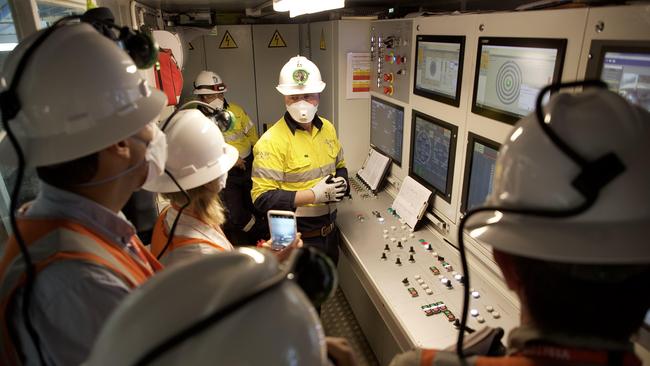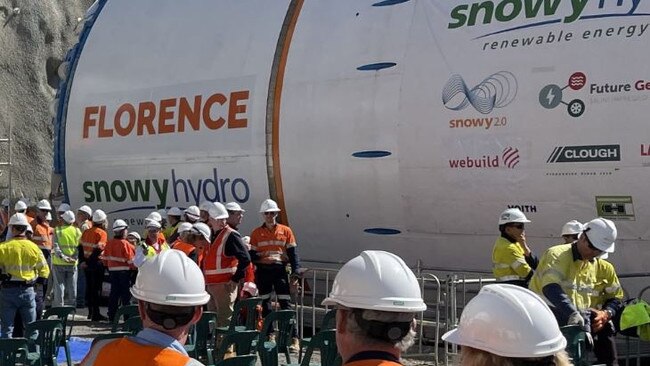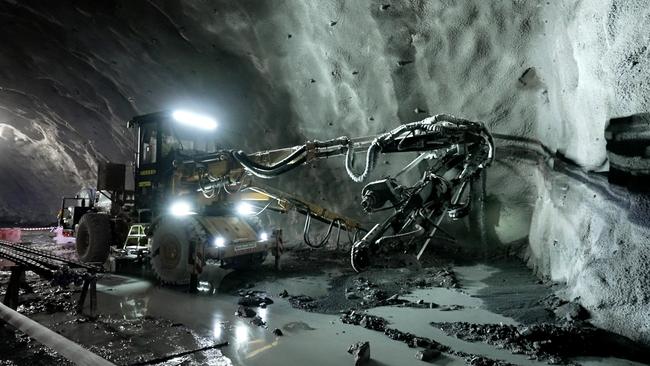’We push, we build’ – how Snowy Hydro is inching towards powering the nation
Snowy Hydro 2.0 will play a critical role in powering Australia. But to realise its vital role, it is moving forward 2m at a time.
Some 80 metres underground in temperatures well in excess of 30C, tunnel boring machine Florence is at the front line of Australia’s energy transition.
Its progress, or lack thereof, has become a metaphor for the country’s attempt to wean its $2.5 trillion economy off its coal dependency.
If Australia is to rapidly reshape its power generation system from its reliance on coal Snowy Hydro’s massive expansion is desperately needed. Australia is installing large amounts of solar and wind, but authorities are increasingly alarmed about what will power the country when the sun is not shining or the wind is now blowing.
Snowy Hydro chief executive Dennis Barnes – a year into the role after being lured out of retirement – said the pumped hydro project, of which the scheme he leads is by far Australia’s largest is the only way the country can deliver on its ambitious plans.
“There is no other technology today. There may be technologies in 15, 20 years, but there is no commercial technology other than pumped hydro that goes beyond four hours,” Mr Barnes said.

Snowy Hydro will use excess renewable energy to pump water uphill. During periods with insufficient renewable generation, water will be released – providing enough electricity to power hundreds of thousands of homes.
But the importance of the Snowy project is matched only by its difficulty.
More than 40km of tunnels must be built, all connecting into a main cavern that will be so deep that it could comfortably hold the Sydney Opera House which will house an underground power station.
While work is progressing on schedule on much of the works, the same cannot be said of the main 16km tunnel.
Florence – one of three near 2000-tonne boring machines – is at the coalface of what Mr Barnes describes as the “critical path”.
Florence became bogged in unexpectedly soft ground in September 2022 and Snowy was forced to rework the tunnel boring machine to allow a so-called closed mode where a crew of a dozen could extract the slurry without contamination.
Eventually after a year delay, Florence got approval to resume operations in December but progress is painstakingly slow.
Nearly 500 metres of the headrace tunnel has now been finished, but Mr Barnes said the developer was poised to remove the metaphoric P Plates.

Florence’s reinforced steel tip moves slowly, creeping forward in two metre increments that can take hours to dig, or claw – which workers say is a more accurate description of the process.
Once Florence’s operator, working from a high-tech operation room metres behind the extractor point, has guided the machine forward, a crew will then install curved, interlinking concrete segments that line the tunnels.
All up, about 130,500 segments will be used to create giant concrete rings across all the tunnels
It is little surprise given the scale of the operation that Florence is moving at a snail’s pace, Mr Barnes said the developer was working to hasten the process and minimise any delays.
“We want to be in a position where we push, we build, we push and we build continuously. We are not there yet, but it will come,” said one Snowy worker.

But while the process is being ironed out, Snowy remains behind schedule. The headrace tunnel requires progress of around 13 metres a day, a feat that the developer is not yet consistently reaching.
Further problems await. In around two years, Snowy will encounter further soft ground, similar to the type that bogged Florence.
Mr Barnes has flagged the prospect of Snowy purchasing another boring machine that would allow the tunnel to be dug from both directions.
Alternatively, another boring machine dubbed Kirsten, which is working on an inclined tunnel, could be reconfigured to accelerate progress.
Mr Barnes said a decision would be made in the next month or two.
But in the meantime, he said the difficulties encountered in the headrace tunnel should not distract from the rapid progress being made across the development.
“Clearly the headrace tunnel as a whole is the critical path: Florence not moving was the lightning rod for the project having its difficulties,” he said.
“It’s incredible how much has happened, it’s really come on. I think it gives us a bit of cover to quietly get on with a good project.”






To join the conversation, please log in. Don't have an account? Register
Join the conversation, you are commenting as Logout